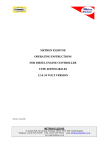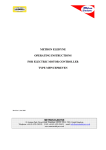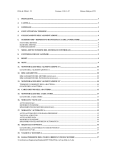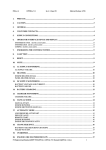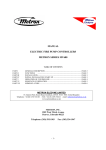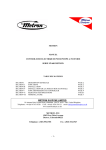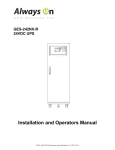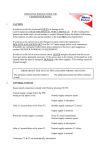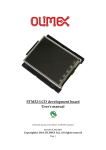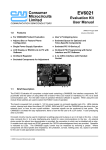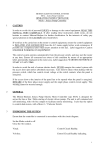Download METRON ELEDYNE OPERATING INSTRUCTIONS FOR DIESEL
Transcript
METRON ELEDYNE OPERATING INSTRUCTIONS FOR DIESEL ENGINE CONTROLLER TYPE EFP/CEPREVEN-v3 12 & 24 VOLT VERSION Revision 1, June 2009 METRON ELEDYNE 18 Autumn Park, Dysart Road, Grantham, LINCS. NG31 7DD. United Kingdom Telephone: +44 (0) 1476 516120 FAX: +44 (0) 1476 516121 email: [email protected] www.metroneledyne.co.uk OP-EFP-CEPREVEN Issue 1 June 2009 METRON ELEDYNE OPERATING INSTRUCTIONS FOR DIESEL ENGINE CONTROLLER EFP-CEPREVEN-v3 1. PG:- 2 CAUTION In order to avoid risk of personal INJURY or damage to the control equipment, READ THIS MANUAL VERY CAREFULLY. If after reading these instructions doubt exists, do not hesitate to contact an Metron Eledyne Engineer for further clarification. In the interests of safety pay special attention to the CAUTION notes listed below: 2. i) If work has to be carried out on the engine or control equipment, isolate the control equipment from the A.C and D.C supplies, and remove the start solenoid supplies from control circuit terminals 9 and 10 before work commences. If possible use a temporary label which draws attention to this fact. ii) Due to the nature of the equipment, the control system may start the engine at any time. Ensure all concerned are aware of this condition by means of an appropriate label, prominently displayed on the engine skid. iii) When the equipment is energised and on line, ensure all doors are closed and where applicable locked. If during commissioning the equipment is energised with the access door to the panel interior open, to avoid the risk of electric shock ensure that extra care is taken and the panel is not left unattended. TRANSPORT & STORAGE INSTRUCTIONS All of the control systems produced by Metron Eledyne are dispatched as complete units and are all protected against corrosion unless otherwise specified. When the control systems leave the factory they have been checked and packed for transportation whether it is by land or by air, the units are always packed in a very safe and secure manner. When the controller is being moved adequate care should be taken. The unit should be moved by equipment that can handle the controller’s weight and care should be taken to ensure the moving equipment has not been overloaded. The controller should be moved with the appropriate lifting straps or slings, or by eye bolts if the unit has them fitted. The controller can be stored until ready for use as long as it has been placed in a vertical manner and is kept in a dry and safe environment to avoid damage to the unit. If the controller is stored for a longer period than 4 weeks arrangements must be made for the unit to contain moisture deterrents so not to damage any of the controllers electric circuits. The moisture deterrent must be removed and discarded once the unit is in full operation. MISUSE OF THIS EQUIPMENT OR MAN HANDLING MAY RESULT IN SERIOUS INJURY OR DEATH - OP-EFP-CEPREVEN Issue 1 June 2009 METRON ELEDYNE OPERATING INSTRUCTIONS FOR DIESEL ENGINE CONTROLLER EFP-CEPREVEN-v3 3. PG:3 GENERAL These operating instructions are applicable to the Metron Eledyne diesel engine fire pump control panel type EFP/CEPREVEN-v3. The control system is a dual battery, fully automatic engine start system which complies generally with the requirements of CEPREVEN. The front panel lamps are of the Light Emitting Diode type and as such are reliable in service. The volt free contact outputs facilitate remote monitoring. DEFINITION OF TERMS USED THROUGHOUT OPERATING INSTRUCTIONS 4. VISUAL PILOT LAMP OR METER. AUDIBLE ELECTRONIC SOUNDER. VOLT FREE REMOTE INDICATING VOLT FREE CHANGEOVER CONTACTS. STANDBY SYSTEM AWAITING AN OPERATIONAL EVENT. CONTROLLER OPTIONS The EFP/CEPREVEN-v3 controller is available with variety of different factory fitted features. These features are listed below:Option A Alternator diode block. Option E2 Second engine heater supply output Option G Anti-condensation heater Option N 24v louver output for 12v controllers Option T1 Cabinet mounting lugs Option T3 Plinth (legs) to enable the controller to be free standing Option T4 Anti- vibration mounting kit Option U1 Pressure transducer, pressure switch and pressure data logging Option Y Printer recorder. OP-EFP-CEPREVEN Issue 1 June 2009 METRON ELEDYNE OPERATING INSTRUCTIONS FOR DIESEL ENGINE CONTROLLER EFP-CEPREVEN-v3 PG:4 ENERGISING THE CONTROL SYSTEM Before Energising the controller all care should be made to ensure that the control system has not been damaged during shipping, if this is the case Metron Eledyne should be contacted immediately. Before connecting the power supplies. Ensure by reference to the circuit diagram, that the installation has been correctly carried out. Please note, Metron Eledyne recommend that a D Type circuit breaker is fitted for incoming mains supply, upstream protection. When applying power to the controller for the first time, the following steps should be performed in this sequence: Check that the contacts of the start pressure switch, terminals 31 & 26, and the auxiliary autostart switch (remote start), terminals 31 & 21 are ALL opened. 2. Disconnect the start solenoids at terminals 9 & 10 to ensure that the engine does not accidentally start. 3. Before attempting to start the engine during commissioning, ensure that the engine Fuel Rack is operable in the stopped position. Or press the controller engine stop push button to ensure that the electrical stop solenoid on the engine operates. 4. Apply A.C & D.C (by closing all internal MCB’s) power, mode switch in Auto mode Visual. Power On. LCD is on showing battery volts and the charging current shows Amps, after short delay 5. Reset controller, the audible alarm stops. The controller is now in Standby status and is indicated as follows:Visual. Battery 1 Healthy Battery 2 Healthy Automatic mode Chargers 230v Present Chargers Healthy All other lamps out Audible. Silent. Volt free Standby Lamp Test When pressing the lamp test push button, the controller’s main board performs a simple self test function, and if the controller is healthy then all the lamps will be illuminated. It is suggested that this push button is pressed after the controller is first switched on. Replace any temporary links with the field connections. connections to terminals 9 & 10. Refit the start solenoid The controller is now ready to be commissioned. Before commissioning commences we strongly recommend that the rest of this manual be read. OP-EFP-CEPREVEN Issue 1 June 2009 METRON ELEDYNE OPERATING INSTRUCTIONS FOR DIESEL ENGINE CONTROLLER EFP-CEPREVEN-v3 5. PG:5 DC SUPPLY MONITORS/BATTERY CHARGERS. FLOAT VOLTAGE & CURRENT LIMIT. The panel is fitted with a panel rating label which provides information regarding float voltage and current limit settings. The label is located at the top of the enclosure door. The information contained on the label must be checked against your specification and the battery manufacturer’s recommendations Two fully automatic battery chargers are fitted and factory set to produce a current limit to a maximum of 8 Amps. The exact current limit setting depends upon the ampere/hour capacity of the batteries. The current decreases to approximately 0.5 Amps at the float level. The battery float voltage level is factory set for the particular installation. If the battery voltage falls below approximately half the float level you will receive a visual indication that the battery has failed by Battery 1 Healthy or Battery 2 Healthy going out. The volt free contacts will indicate a System Fault, if the charger is then enabled, charging will begin and the LCD ammeter will read the current limit value. When the battery has been recharged to a few volts above the failure threshold, the alarms can be cancelled by pressing the Reset pushbutton. The charging of the battery will continue until the float level has been reached. NOTE:Maintenance of batteries should be carried out in accordance with the instructions issued by the battery manufacturer. A weekly check should be made on the state of charge and the electrolyte level, to ensure that the plates are always covered. Only pure distilled water should be used for battery topping up. BATTERY BOOST CHARGING. Consult your battery manufacturers before starting to use this facility. We recommend that battery boost only be used at the installation commissioning stage. With the power on, pressing the Boost charge push button which is located on each battery charger will cause the battery Boost to commence. The voltage will steadily rise. When the current has reduced to a minimum steady value and the voltage has risen to approximately 2 volts above the float level, the input to the battery has reached its maximum values and the boost is complete. To stop the boost the Boost push button is pressed again and the system will return to float voltage, alternatively the boost timer will reset automatically after 8 hours. OP-EFP-CEPREVEN Issue 1 June 2009 METRON ELEDYNE OPERATING INSTRUCTIONS FOR DIESEL ENGINE CONTROLLER EFP-CEPREVEN-v3 PG:6 NOTE:Care should be taken at all times when the control system is boost charging this is due to the fact that leaving the system in boost could be dangerous. Excessive boosting of the batteries will cause them to emit hydrogen gas, which may result in damage. Ensure that the surrounding area of the batteries is well ventilated. BATTERY DISCONNECTION. If the controller is affected by a battery disconnected condition, DC supply visual indication will be by Battery 1 Healthy or Battery 2 Healthy going out. The volt free contacts will indicate a System Fault, if both of the batteries are affected by this then the controller will be blacked out. Visual. Volt Free. Battery 1 or 2 Healthy goes out. Battery Failed AC or DC Failed Alarms in service System Fault. Audible. Mutable When the battery has been reconnected the Reset button will need to be pressed in order to bring the controller back to a standby state. CHARGER FAILURE. Should the charger stop charging for period longer than 160 seconds, the charger will sense this and instigate a Charger Failure alarm. Visual. Volt Free. Charger Healthy – Goes out. Alarms in service System Fault Audible. Mutable AC FAILURE. Should there be an AC failure, then Visual. AC or DC Failed Mains Supply failed Alarms in service Charger 230v - off After 30s Chargers Healthy – goes out Volt Free. AC Mains Failure Audible. Mutable. Upon mains restoration the above conditions clear without a reset required. OP-EFP-CEPREVEN Issue 1 June 2009 METRON ELEDYNE OPERATING INSTRUCTIONS FOR DIESEL ENGINE CONTROLLER EFP-CEPREVEN-v3 BATTERY CHARGER LAYOUT The Controller contains two battery chargers 1 & 2. The charger is of an advanced design which contains features such as :8 HOUR BOOST CHARGING VIA PB1 (Manual or Automatic Boost Reset) CHARGER FAILURE. CHARGE FROM A DEAD FLAT BATTERY, VIA PB2 VARIABLE FLOAT VOLTAGE. VARIABLE CURRENT LIMITING. Please refer to the Metron Eledyne ‘Set Up Procedure Type PC195’ for more information regarding to the set up of this module. (Available upon request.) See Appendix A, for battery safety information. PG:7 OP-EFP-CEPREVEN Issue 1 June 2009 METRON ELEDYNE OPERATING INSTRUCTIONS FOR DIESEL ENGINE CONTROLLER EFP-CEPREVEN-v3 7. PG:8 AUTOMATIC START SEQUENCE. With the controller in standby and Automatic mode selected, should the pressure drop, closing the pressure switch contacts across terminals 31 & 26, or by closing the Priming tank low contacts (terminals 31 & 22), or by closing the remote start contacts (terminals 31 & 21) then the Pump on Demand LED will illuminate, volt free contacts will indicate Pump on Demand and a crank sequence will commence. Visual. Pump on Demand. Volt Free. Pump on Demand. CRANK SEQUENCE When a crank sequence begins, the engine will be cranked by battery 1. If the engine does not start immediately the crank will continue for 12 seconds, the crank sequence routine will then proceed with a 8 second dwell before repeating this crank and rest time on the other battery. The OID panel will illuminate the appropriate CRANK indicator, the cranking battery charger will be off, and the cranking battery voltmeter will also drop during the cranking time. This sequence will continue until either the engine starts or 6 crank attempts have been completed, when a failed to start alarm will occur: Visual. Failed to Start Alarms in service Volt Free. System Fault. Failed to Start Audible Muteable In order to reset the alarm, first ensure that the Pump On Demand has been cancelled, then operate turn the mode switch to the off mode, then back to auto and the controller will return to standby. The controller can then be started by the test start push button in automatic mode, or by the individual start push buttons in manual mode. BATTERY FAILURE DURING CRANKING. As the starter motor engages, the battery voltage dips briefly to a low value and then recovers to a higher steady value during cranking. With a poor battery, the steady cranking voltage eventually falls below the fault level of approximately half the float voltage, this voltage drop is sensed and all remaining attempts are transferred to the other battery. Note: The battery failure level is set in screen 306, and failure time is set in 307. ENGINE RUNNING. After a pump on demand signal has been received, the engine will be cranked and will normally start immediately. The engine starting will cause an engine running signal which is produced by an electronic speed switch incorporated on the mother board and by use of special software, which is fed by a signal originating from a magnetic pickup mounted on the engine. The run signal will immediately halt the cranking, show RPM on the OID screen and the volt free contacts will indicate Engine Running. OP-EFP-CEPREVEN Issue 1 June 2009 METRON ELEDYNE OPERATING INSTRUCTIONS FOR DIESEL ENGINE CONTROLLER EFP-CEPREVEN-v3 Visual. Volt Free. Pump on Demand. Pump at/not pressure – red (after screen 304 time) Alarms in service Engine Running. (x2) Audible Mutable PG:9 HOURS RUN METER & TACHOMETER. The OID panel shows the Engine hours run total (on system status screen 4) and engine speed tachometer operates whenever the engine is running. PUMP AT/NOT PRESSURE While the engine is running the external pump running pressure switch is monitored. While the pump running pressure switch is open with the engine running, this indicator is red to signal that the pump is NOT running at pressure (set in screen 119). When the pump running pressure switch closes, this indicator will be green to indicate that the pump IS running at pressure. When the engine stops, this indicator will be off regardless of the pump running pressure switch status. If the pump does not reach pump running pressure within the time period set in parameter 119 (10s default) then: Visual Volt Free Pump at/no pressure – red Alarms in service System Fault Audible Muteable Note: Lamp will stay green after the engine stops until the pump running pressure switch contact opens. 8 STOPPING THE ENGINE. When the Pump On Demand indications have cleared it is safe to stop the engine, which will cancel the engine running indications. The engine should not be stopped when the Pump On Demand LED is on as the engine will restart immediately the engine running signal is lost. If, for overriding safety reasons, the engine must be stopped in the presence of a Pump On Demand, the mode switch must turned to the off or manual position and then the engine can be stopped. The engine can be stopped by pressing the stop push button located on the cabinet door. Once pressed, then the energize to stop solenoid output is energized for a predetermined time period. The engine will not be available to start again until this time period has elapsed. Factory pre-set to 15 seconds. OP-EFP-CEPREVEN Issue 1 June 2009 METRON ELEDYNE OPERATING INSTRUCTIONS FOR DIESEL ENGINE CONTROLLER EFP-CEPREVEN-v3 12 PG:10 MANUAL START Select manual mode: Visual Manual Mode Not in Auto Crank 1 or Crank 2 when the appropriate p.b is pressed Alarms in service Volt free Not in automatic Audible Mutable In this condition, the two manual start push buttons are active. Please note that as soon as the engine starts then the push button must be immediately released since there is no automatic function to release the starter motor since this is a purely manual function. 13 ENGINE MONITORING The controller is equipped with a low oil pressure, low driving pressure and high water temperature monitor, which are active after the contacts have been closed for 10 seconds (see parameter 304) after the engine has been running: With the engine running, low oil pressure contact closes Visual Low oil pressure Alarms in service After a 10 second delay Audible Muteable Volt free System fault If the engine is stopped, or if the low oil pressure contacts open, then the low oil pressure conditions indicated above will clear after a manual reset. The high water temperature alarm and low driving pressure operates in an identical manner to the low oil pressure monitor, but the lamp comes on ONLY after the 10 second delay. OP-EFP-CEPREVEN Issue 1 June 2009 METRON ELEDYNE OPERATING INSTRUCTIONS FOR DIESEL ENGINE CONTROLLER EFP-CEPREVEN-v3 14 PG:11 NON ENGINE RELATED FAULT CHANNELS The controller includes a various number fault channel monitoring, including: Low fuel Level (2 second on delay) Reserve Low Level (Instant Alarm) Priming Tank Low (Instant Alarm) – crank is initiated if in auto mode Starter Motor Fault (2 second on delay, and inhibited while cranking) When the fault contacts close, which is active at all times regardless of the controller mode or if the engine is running or not, then: Visual Volt free Channel Designation Alarms in service System fault Alarm Muteable When the fault clears, (contacts open), the controller returns to standby, after the reset push button has been operated. 15 ENGINE OVERSPEED The controller is designed with a built in speedswitch, which is done in part by hardware and part by software. The hardware cleans up and isolates the pulses from the magnetic pick up device and provides a clean and safe pulse to the microprocessor for the software to analyze. The software uses parameters: 321 319 320 Number of pulses per revolution This should be set to the number of flywheel teeth on the engine if the magnetic pick up device is mounted to the flywheel. Cut Crank speed This should be set to 600rpm, and is the engine running set point Engine Overspeed This should be set in accordance to CEPREVEN standards, and is typically set to +10% of the running speed. If the engine running speed exceeds the engine overspeed set point then: Visual Volt free Engine Overspeed Alarms in service System fault Alarm Muteable If parameter 121 is set to ‘YES’ then the engine will automatically shutdown. When the fault has cleared, the reset push button must be operated in the OFF mode to clear the fault channel. OP-EFP-CEPREVEN Issue 1 June 2009 METRON ELEDYNE OPERATING INSTRUCTIONS FOR DIESEL ENGINE CONTROLLER EFP-CEPREVEN-v3 PG:12 Disposal Metron Eledyne Ltd are a member of a compliance scheme under the Waste Electrical and Electronic Equipment regulations which is applicable in all EEC countries. At the end of the service life of the equipment the company offers to collect and dispose of this equipment in accordance with regulations in force under the Registration Number WEE/CF0105WV.(Equipment must be suitably packed for collection by courier if outside the UK). Contact: Tel 00 44 (0)1476 516120 Fax.00 44 (0)1476 516121 OP-EFP-CEPREVEN Issue 1 June 2009 METRON ELEDYNE OPERATING INSTRUCTIONS FOR DIESEL ENGINE CONTROLLER EFP-CEPREVEN-v3 PG:13 APPENDIX A SAVE THESE INSTRUCTIONS -THIS MANUAL SECTION CONTAINS IMPORTANT SAFETY AND OPERATING INSTRUCTIONS FOR THE METRON ELEDYNE BATTERY CHARGER TYPE. A. USE OF THE BATTERY CHARGER. The battery charger is intended for use only in Metron Eledyne control systems. Use of an attachment/connector not recommended or sold by Metron Eledyne may result in a risk of fire, electric shock or personal injury. B. REMOVING THE BATTERY CHARGER. If the battery charger should be required to be removed from the controller, to reduce the risk of damage to the electrical connections, pull the connector rather than the connecting cables. C. DO NOT DISASSEMBLE THE BATTERY CHARGER. Do not in any circumstances disassemble the battery charger, there are no user serviceable parts inside. Incorrect reassembly may result in electric shock, fire or risk of serious personal injury. D. WARNING. The performance of the battery chargers is entirely automatic. No operator variables are provided, the chargers are factory preset and NO ADJUSTMENTS MUST BE ATTEMPTED ON SITE or damage to the batteries may result. Maintenance of batteries should be carried out in accordance with the instructions issued by the battery manufacturer. E. WARNING - RISK OF EXPLOSIVE GASES Working in the vicinity of a LEAD-ACID/NI-CAD Battery is very dangerous. Batteries generate explosive gases during normal battery operation. To reduce the risk of battery explosion read the controller operating manual completely, and the battery manufacturers data. Equipment used in the vicinity of the batteries should also be carefully selected. THE EFP-CEPREVEN CONTROLLER SHOULD BE USED AS EXPLAINED IN THE ABOVE GUIDELINES OR THE WARRANTY MAY BE VOID OP-EFP-CEPREVEN Issue 1 June 2009 METRON ELEDYNE OPERATING INSTRUCTIONS FOR DIESEL ENGINE CONTROLLER EFP-CEPREVEN-v3 Appendix B. OID Screen Map - Showing default values 1 CONFIG 1) SYSTEM SETPOINTS 2) USER PREFERENCES 3) TECH SCREENS 2 CONFIG 1) ANALOG SIGNALS 2) AUXILLIARY ALARMS 101 SYSTEM SETPOINTS Engine Start Pressure [100.0]psi 0-999.9 201 USER PREFERENCES Set System Real Time Clock [17:03:52] 301 TECH SCREENS SPECIAL: Engine Minimum Run Time [No ] 400 ANALOG SIGNALS Analog Input 01 Slope: [0.2135677] 501 AUX USER PROGRAM AUX# 1 Enabled [Yes] 102 SYSTEM SETPOINTS Engine Stop Pressure [110.0]psi 0-999.9 202 USER PREFERENCES Set System Date [02/16/03] 302 TECH SCREENS SPECIAL: Engine Minimum Run Time [15]minutes 1-99 401 ANALOG SIGNALS Analog Input 01 Offset: [- 75.6030] 502 AUX USER PROGRAM AUX# 1 Input Number [30] 0-53 103 SYSTEM SETPOINTS Engine Start Delay Time [ 1] seconds 1-999 203 USER PREFERENCES Set System Day Of The Week [Sun] 303 TECH SCREENS Energized To Stop Fuel Solenoid Time [10]seconds 0-99 402 ANALOG SIGNALS Analog Input 1 651 Minimum Counts [ 200] 503 AUX USER PROGRAM AUX# 1 Input Contact Type [NO ] 104 SYSTEM SETPOINTS Engine Automatic Stop Enabled [No] 204 USER PREFERENCES Log System Pressure Drop Events [Yes] 304 TECH SCREENS Alarms in Service Delay Time [10]seconds 1-99 410 ANALOG SIGNALS Analog Input 02 Slope: [0.0350000] 504 AUX USER PROGRAM AUX# 1 Trip Time [ 0]sec 0-999 105 SYSTEM SETPOINTS Engine Minimum Run Time [30]minutes 30-99 205 USER PREFERENCES Low Pressure Event Trip Pressure [ 60.0]psi 0-999.9 305 TECH SCREENS Nominal Battery Voltage [24]VDC 10-99 411 ANALOG SIGNALS Analog Input 02 Offset: [ 0.0000] 505 AUX USER PROGRAM AUX# 1 Reset Time [ 0]sec 0-999 106 SYSTEM SETPOINTS Automatic Weekly Engine Test Run [No] 206 USER PREFERENCES Low Pressure Event Reset Time [15] seconds 0-20 306 TECH SCREENS Battery Low Voltage Alarm Trip Voltage [ 12]VDC 8-99 412 ANALOG SIGNALS Analog Input 2 1174 Minimum Counts [ 0] 506 AUX USER PROGRAM AUX# 1 Auto Reset Enabled [Yes] 107 SYSTEM SETPOINTS Auto Weekly Engine Test Day Of The Week [Mon] 207 USER PREFERENCES Time Between Pressure Log Samples [ 15] seconds 15-999 307 TECH SCREENS Battery Low Voltage Alarm Trip Time [ 2]seconds 0-99 420 ANALOG SIGNALS Analog Input 03 Slope: [0.0350000] 507 AUX USER PROGRAM AUX# 1 Horn Enabled [No ] 108 SYSTEM SETPOINTS Auto Weekly Engine Test Start Time [10:00:00] 208 USER PREFERENCES Auto Print Each Pressure Log Sample [No ] 308 TECH SCREENS Change Tech Password [******] 421 ANALOG SIGNALS Analog Input 03 Offset: [ 0.0000] 508 AUX USER PROGRAM AUX# 1 Horn Silence [No ] 109 SYSTEM SETPOINTS Auto Weekly Test Length Of Run Time [30] minutes 30-99 209 USER PREFERENCES Auto Print Each Event Log Entry [No ] 309 TECH SCREENS Password Logout Time [ 5] minutes 1-15 422 ANALOG SIGNALS Analog Input 3 1225 Minimum Counts [ 0] 509 AUX USER PROGRAM AUX# 1 LED Number [ 0] 0-24 110 SYSTEM SETPOINTS Auto Weekly Test Oil/Water Shutdown [No] 210 USER PREFERENCES Selective Range Printing [ 1] Before 1-99 310 TECH SCREENS System Commissioned Date [00/00/00] ANALOG INPUT COUNTS 649 1176 1221 0 0 0 0 0 0 0 510 AUX USER PROGRAM AUX# 1 Output1 Number [ 0] 0-19 111 SYSTEM SETPOINTS Power Failure Engine Startup [No] 211 USER PREFERENCES Selective Range Printing [ 1] After 1-99 311 TECH SCREENS Expiration Time For Test Settings [ 5]minutes 1-60 424 BATTERY 1 Constant A xA^3 + xB^2 + xC + D [ 0.0000] 511 AUX USER PROGRAM AUX# 1 Output2 Number [ 0] 0-19 112 SYSTEM SETPOINTS Power Failure Engine Start Delay Time [ 1] minutes 0-500 212 USER PREFERENCES LCD Back Light Mode 0=Always on [0]] 1=Power Save 312 TECH SCREENS STARTUP TEST: Test Settings Enabled [No ] 425 BATTERY 1 Constant B xA^3 + xB^2 + xC + D [ 0.0000] 512 AUX USER PROGRAM AUX# 1 Output3 Number [ 0] 0-19 113 SYSTEM SETPOINTS Pressure Transducer Failure Engine Start [No] 213 USER PREFERENCES Language Select 0=English, 1=Spanish [0] 313 TECH SCREENS STARTUP TEST: Engine Minimum Run Time [15]minutes 1-99 426 BATTERY 1 Constant C xA^3 + xB^2 + xC + D [ 0.004190] 513 AUX USER PROGRAM AUX# 1 Record In Event Log [No ] 214 USER PREFERENCES Change User Password Level 1 [****] 314 TECH SCREENS FACTORY TEST: Test Settings Enabled [No ] 427 BATTERY 1 Constant D xA^3 + xB^2 + xC + D [- 0.096642] 514 AUX USER PROGRAM AUX# 1 Text Message Number [ 0] 0-27 215 USER PREFERENCES Save Aux alarms to SD memory card [ No] 315 TECH SCREENS FACTORY TEST: Engine Crank Time [15]seconds 1-15 428 BATTERY 1 Volts per count 515 AUX USER PROGRAM AUX# 1 Engine Run Dependent [No] 216 USER PREFERENCES Load Aux alarms from SD memory card [No] 316 TECH SCREENS FACTORY TEST: Engine Crank Rest Time [15]seconds 1-15 [ 317 TECH SCREENS Alarm Log 1/10 Event Log 1/1569 Pr. Log 1/25123 430 BATTERY 2 Constant A xA^3 + xB^2 + xC + D [ 0.0000] 318 TECH SCREENS Pressure Transducer [No] 431 BATTERY 2 Constant B xA^3 + xB^2 + xC + D [ 0.0000] 319 TECH SCREENS Engine Running Speed [600]rpm 300-999 432 BATTERY 2 Constant C xA^3 + xB^2 + xC + D [ 0.004190] 320 TECH SCREENS Engine Overspeed Alarm [3600] 1000-9999 433 BATTERY 2 Constant D xA^3 + xB^2 + xC + D [- 0.096642] 321 TECH SCREENS Pulses Per Revolution [130] 1-999 434 BATTERY 2 Volts per count 119 SYSTEM SETPOINTS Pump at Pressure Delay Time [ 10]seconds 0-999 120 SYSTEM SETPOINTS Pressure Switch Engine Start [No ] 121 SYSTEM SETPOINTS Engine Overspeed Shutdown [Yes] 122 SYSTEM SETPOINTS High System Pressure Alarm [175.0]psi 999.9 [1.0000000] 429 BATTERY 1 Minimum Amps 1.0] [1.0000000] 435 BATTERY 2 Minimum Amps [ 1.0] PG:14














